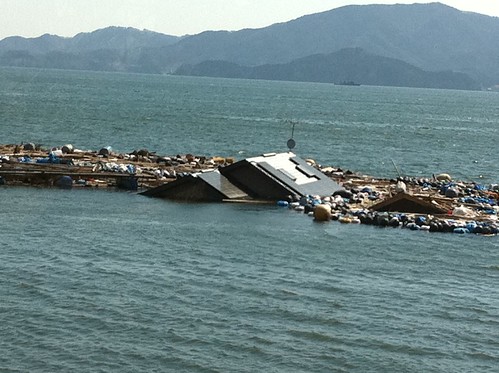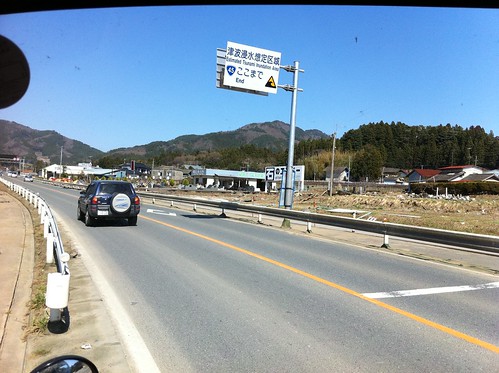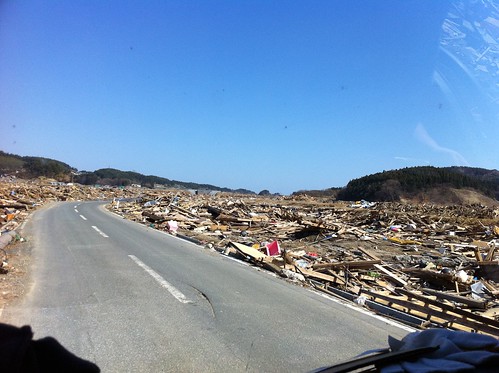
Where to start..? This will hopefully be the last note that I do as I don’t think it will be needed for us to physically go north with aid, but I also think this might be the hardest to write.
The simple facts are these:
Robert Half in Tokyo funded the truck, we picked up some stuff from Scott in Roppongi that had been donated by the TAC and Baxter medical. We collected more donations from Second Harvest and drove North to our base in Mizusawa. We bought a lot of fruit and vegetables in Kitakami and spent Sunday and Monday morning distributing about 3 tons of Aid to those who most need it and arrived back in Tokyo at around 9 pm on Monday night.
But that doesn’t begin to describe the weekend. Dave mentioned that in my previous notes I managed to write a lot but report very little which was something I’d perfected studying Geography at University. So for this one I will try to report in some kind of detail but it won’t begin to cover everything that needs to be said.

On Sunday morning we drove to ‘Super Osen’, a fruit and veg warehouse in Kitakami. It was probably the busiest store that I have seen in Japan. It was absolutely packed as it seems that everyone in the area had descended to do their grocery shopping. After eventually finding somewhere to park the truck Dave spoke to one of the warehouse operators and convinced him that yes, we really did want to spend 100,000 yen on fruit and veg and after that a well oiled machine kicked in to place. We opened the truck doors and were inundated with apples, oranges, onions, potatoes, carrots, cabbages, daikon etc.
10 minutes later, the truck was full and we’d spent 130,000 yen. I have no idea about exactly how much we bought but we’d bought 200 kg of onions alone. And I’d guess the apples were pretty close to double that.
The initial plan had been to head down to Rikuzentakata and through the Hirota peninsular before ending up somewhere near Okirai. Once we’d seen how much food we could get we then decided that we’d go back the next day and fill up with another similar load and go to the Rikuzentakata main distribution centre on the way home.
We headed off in good spirits with a full truck and a couple of stinking hangovers. I seem to have omitted the fact that we over did our attempts to help the local economy but suffice to say we got our money’s worth and were paying for it the next day.
Two weeks ago I’d never been to Iwate. I now know that it is one of the most beautiful places in Japan. We drove through fields and country villages nestled in the hills and it was absolutely gorgeous.
We then started our descent into Rikuzentakata and the scene changed dramatically.

We were seven kilometers from the ocean when we first reached the area that had been destroyed by the tsunami. As we drove the right side of the road, beyond the train tracks was gone. The left side was still standing. It seems that the slight embankment for the tracks had been enough at this point to prevent the tsunami from crossing the road.
On the left, completely normal. On the right, completely gone.
And this was SEVEN kilometers inland.
As we drove in, the scene just got worse and worse and worse to a point where all you could see in every direction was destruction. There are no houses except for those which are on their roofs or in a location they weren’t built in. Some concrete buildings are still standing. Others have been completely gutted and all that’s left are the iron girders.
Cars, trucks etc have been dumped where the water left them.
On first viewing there was very little in the way of a clean up operation going on. They had cleaned the roads but that seemed to be it. As we drove through the town it became clear that a lot of work had been done. A new road had been put down in places. A temporary bridge had been built to replace the one that had been washed away.
When I first went to Kesennuma I used the word horrific to describe what we saw. If that was horrific then I have no idea how you could describe the scene in Rikuzentakata. I don’t think there is a word in the English language that can completely describe what we saw and what happened there. The roads are open and they are lined with two, three even four metre piles of debris. The supermarket is still standing, but the three floors have been destroyed.
We passed a sign that said ‘Estimated Tsunami Inundation Area End’. It was wrong.

We eked our way along the coast. Along roads that had been partially washed away, past houses that were in the ocean, past the sea wall with massive holes in that you could safely drive a boat through, past so much that was just so very wrong. We drove around the peninsular which was absolutely stunning, and then we’d drive round a corner that was absolute devastation. It’s impossible for me to describe the contrast that we experienced with pretty much every turn. My frown caused a headache.
Dave thought it might be a hangover but it wasn’t. As I write these words now the frown is back as I try to remember what we saw and so is the headache.
We eventually made it to our first stop, the Hirota Elementary School where we were able to deliver about 70% of the fresh produce we had brought as well as some of the other stuff such as nappies, face masks and cling film.
During this Dave bumped into someone he knew from ‘back in the day’ and he was clearly delighted and somewhat emotional that Dave had come back to help.
We then drove to the Okirai and dropped off the rest of the fresh produce. They didn’t need any of the other stuff we had but were still very, very happy for fresh food.
On Monday we returned to the wholesalers and bought another 135,000 yen’s worth of produce and drove back to Rikuzentakata where we delivered everything we had.
In Rikuzentakata they have Koi streamers on display and a temporary onsen. The petrol station is operated by a hand crank and they seem to have fuel. Life is trying to move on.
But the town, which used to house 23,000 people, has gone.

Thanks again to everyone who helped this project and please keep supporting because there is so much that still needs to be done.
The simple facts are these:
Robert Half in Tokyo funded the truck, we picked up some stuff from Scott in Roppongi that had been donated by the TAC and Baxter medical. We collected more donations from Second Harvest and drove North to our base in Mizusawa. We bought a lot of fruit and vegetables in Kitakami and spent Sunday and Monday morning distributing about 3 tons of Aid to those who most need it and arrived back in Tokyo at around 9 pm on Monday night.
But that doesn’t begin to describe the weekend. Dave mentioned that in my previous notes I managed to write a lot but report very little which was something I’d perfected studying Geography at University. So for this one I will try to report in some kind of detail but it won’t begin to cover everything that needs to be said.

On Sunday morning we drove to ‘Super Osen’, a fruit and veg warehouse in Kitakami. It was probably the busiest store that I have seen in Japan. It was absolutely packed as it seems that everyone in the area had descended to do their grocery shopping. After eventually finding somewhere to park the truck Dave spoke to one of the warehouse operators and convinced him that yes, we really did want to spend 100,000 yen on fruit and veg and after that a well oiled machine kicked in to place. We opened the truck doors and were inundated with apples, oranges, onions, potatoes, carrots, cabbages, daikon etc.
10 minutes later, the truck was full and we’d spent 130,000 yen. I have no idea about exactly how much we bought but we’d bought 200 kg of onions alone. And I’d guess the apples were pretty close to double that.
The initial plan had been to head down to Rikuzentakata and through the Hirota peninsular before ending up somewhere near Okirai. Once we’d seen how much food we could get we then decided that we’d go back the next day and fill up with another similar load and go to the Rikuzentakata main distribution centre on the way home.
We headed off in good spirits with a full truck and a couple of stinking hangovers. I seem to have omitted the fact that we over did our attempts to help the local economy but suffice to say we got our money’s worth and were paying for it the next day.
Two weeks ago I’d never been to Iwate. I now know that it is one of the most beautiful places in Japan. We drove through fields and country villages nestled in the hills and it was absolutely gorgeous.
We then started our descent into Rikuzentakata and the scene changed dramatically.

We were seven kilometers from the ocean when we first reached the area that had been destroyed by the tsunami. As we drove the right side of the road, beyond the train tracks was gone. The left side was still standing. It seems that the slight embankment for the tracks had been enough at this point to prevent the tsunami from crossing the road.
On the left, completely normal. On the right, completely gone.
And this was SEVEN kilometers inland.
As we drove in, the scene just got worse and worse and worse to a point where all you could see in every direction was destruction. There are no houses except for those which are on their roofs or in a location they weren’t built in. Some concrete buildings are still standing. Others have been completely gutted and all that’s left are the iron girders.
Cars, trucks etc have been dumped where the water left them.
On first viewing there was very little in the way of a clean up operation going on. They had cleaned the roads but that seemed to be it. As we drove through the town it became clear that a lot of work had been done. A new road had been put down in places. A temporary bridge had been built to replace the one that had been washed away.
When I first went to Kesennuma I used the word horrific to describe what we saw. If that was horrific then I have no idea how you could describe the scene in Rikuzentakata. I don’t think there is a word in the English language that can completely describe what we saw and what happened there. The roads are open and they are lined with two, three even four metre piles of debris. The supermarket is still standing, but the three floors have been destroyed.
We passed a sign that said ‘Estimated Tsunami Inundation Area End’. It was wrong.

We eked our way along the coast. Along roads that had been partially washed away, past houses that were in the ocean, past the sea wall with massive holes in that you could safely drive a boat through, past so much that was just so very wrong. We drove around the peninsular which was absolutely stunning, and then we’d drive round a corner that was absolute devastation. It’s impossible for me to describe the contrast that we experienced with pretty much every turn. My frown caused a headache.
Dave thought it might be a hangover but it wasn’t. As I write these words now the frown is back as I try to remember what we saw and so is the headache.
We eventually made it to our first stop, the Hirota Elementary School where we were able to deliver about 70% of the fresh produce we had brought as well as some of the other stuff such as nappies, face masks and cling film.
During this Dave bumped into someone he knew from ‘back in the day’ and he was clearly delighted and somewhat emotional that Dave had come back to help.
We then drove to the Okirai and dropped off the rest of the fresh produce. They didn’t need any of the other stuff we had but were still very, very happy for fresh food.
On Monday we returned to the wholesalers and bought another 135,000 yen’s worth of produce and drove back to Rikuzentakata where we delivered everything we had.
In Rikuzentakata they have Koi streamers on display and a temporary onsen. The petrol station is operated by a hand crank and they seem to have fuel. Life is trying to move on.
But the town, which used to house 23,000 people, has gone.

Thanks again to everyone who helped this project and please keep supporting because there is so much that still needs to be done.

No comments:
Post a Comment